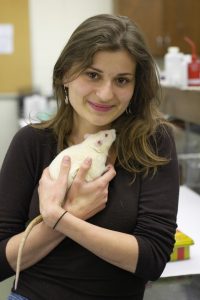
UBC Animal Welfare Researchers Receive International 3Rs Prize
March 8, 2017
Congratulations to UBC Animal Welfare Program researcher Joanna Makowska and Professor Dan Weary on receiving the prestigious 2016 3Rs prize for their paper investigating the welfare of laboratory rats.
The prize, awarded by the UK’s National Centre for the 3Rs (NC3Rs) and sponsored by GlaxoSmithKline, consists of a £28k prize grant and a £2k personal award. Makowska, who earned her PhD from the UBC Animal Welfare Program in 2016 will use the grant to further explore how important specific behaviours are to laboratory rats.
Makowska and Weary’s prize winning paper provides evidence of the importance of simple and natural behaviours such as burrowing and standing upright (rearing) to rat welfare. Standard rat caging in the laboratory does not typically accommodate these behaviours. Lab animal regulations in the EU and North America set out guidelines for the minimum cage height that should be provided for animals. For rats, this is 18 to 20 cm, but rats stand upright at 22 cm by 2.5 months of age and 26-30 cm when they are fully grown. The key questions are whether this restriction in their behavioural repertoire affects rat welfare and the science the animals are used for.
The answer to the first question is likely to be ‘yes’, based on Makowska’s work. The research team observed the behaviour of laboratory rats housed in large and enriched semi-naturalistic cages. They found that throughout their lives rats burrow readily, even when tunnels are already present, re-organising the tunnels on an almost daily basis. When allowed the space in large cages, young rats stand upright on average 180 times per day, and even when relatively old (13 months) up to 75 times daily. In comparison, rats housed in standard laboratory caging are unable to burrow or to stand up straight, and they show almost nine times more lateral stretching than rats in large cages; Makowska and Weary suggest that this behaviour is used to alleviate the stiffness caused by the inability to stretch upright and the generally low levels of mobility in standard cages.
“The difference in behaviours between rats in a naturalistic setting and those housed in standard laboratory cages was stark,” said Makowska. “Our work has already led to some researchers changing their rat housing to accommodate some of the features described in our paper. It is an honour to have this work recognised by the NC3Rs. There is much more to do and the award from the NC3Rs and GSK will allow me to pursue this line of research in more depth, to provide even more evidence of what rats need and how to meet those needs in a feasible way. My aim is to provide rats with a good quality of life.’
Tagged with: